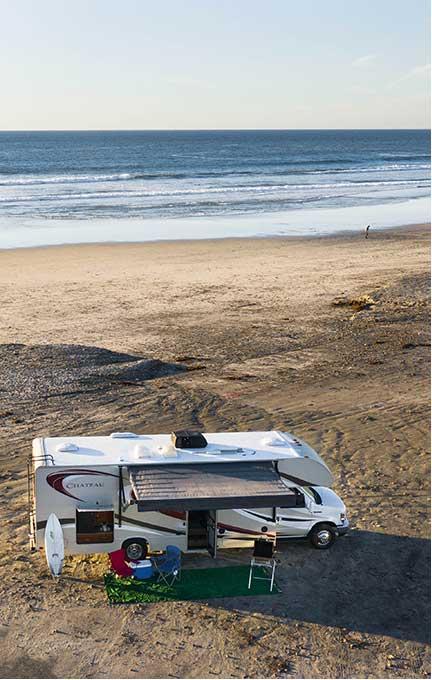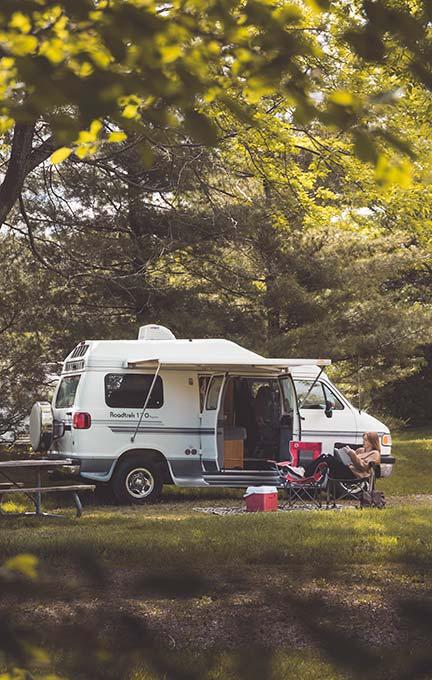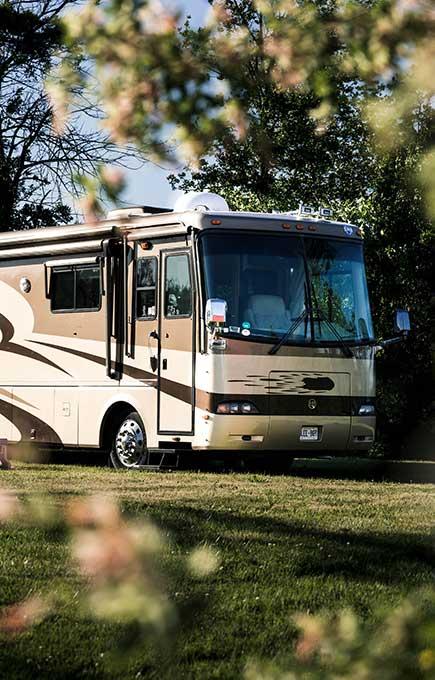Tire blowouts are one of the more common causes of RV accidents. Fortunately, a small amount of attention and care can go a long way in ensuring it never happens to you. A little RV tire safety goes a long way.
In this blog, we cover 3 ways to keep your tires in check and safe for the ride. Let’s talk:
- Tire inspection
- Air pressure
- Overloading
Inspect your tires
A quick tire inspection is your first stop for tire safety. Your goal is to make sure your RV tires are in good working condition. An inspection should be done each time before you take your RV out on the road.

Here are the things you are looking for.
Tread wear
When the treads wear down on your tires, it is time to replace them. Any depth of 2/32 of an inch or less means they need to be replaced right away. The famous “penny test” can detect this. Stick a penny into the treads with the head of Lincoln pointed to the tire. If you can see his whole head, the tire tread is too low. Many tires also have a wear gage, a sunken feature of the tread pattern. If that part is flush with the treads, that tells you it is time for new tires. Tires don’t always wear out evenly, so check more than one spot on each tire.
Tread separation
The outer treads are bonded to the tire. The bonding agent can weaken over a long period of time or under great stress. Look for significant cracking along the edge of the tread on the outside of the tire. A little bit is fine, but deep cracks could be a real problem.

Other cracking
Small cracks in a tire are not unusual. Little hairline surface cracks will develop from normal stresses on the tire. But any crack that is deep or wide is a sign of serious trouble.
Sidewall integrity
The sidewalls of the tire are where blowouts most often happen. If you see any of the inner layers of the tire exposed showing metal or fabric threading, that’s a red flag. Another is unusual bulges in the surface of the sidewall in one specific spot. If you see either of those, the tire is not safe.
Foreign objects
Search for any nails stuck in the tires. If you find any, you should get them removed and repaired. Rocks between the treads are not a danger, but they can increase tread wear so it’s a good idea to pop them out when you do an inspection.
Check air pressure
Check Tire pressure before you start a trip, and once a week while you are out on the road. You should also check pressure if you have changed altitude by more than 1,000′ or if the average temperature has changed by more than 30 degrees Fahrenheit. High altitude will raise tire pressure as will high temperature.
Losing some tire pressure over time is perfectly normal, but if you lose 20% or more within a week, check the tire for any nails or other foreign objects that may be causing a slow leak.

Your first order of business is to know what the proper inflation level is for your tires. This information should be indicated on the RV itself, usually on a metal plate. If it is not, look it up in the owner’s manual. Proper inflation depends both on the tires and the weight of the RV, so use the RV’s value rather than the tire’s listed maximum.
Once you know the proper pressure, make sure to inflate to the number exactly whenever you are checking on the tires. If you find them a little over, just leave them be. If they are a little under, pump them up until they are right on the mark. I recommend keeping a portable tire inflator (like this one) so you can do this anywhere.
Don’t overload
Perhaps the most important RV tire safety tip is not directly related to the tires themselves: don’t overload your RV. Exceeding the maximum weight for your RV puts stress on your tires beyond what they were designed for. They can likely take it for a time, but the longer you drive over-weight, the more likely a blowout becomes. Likewise, a very uneven load in your RV can lead to uneven wear and put excessive pressure on specific tires.

If you have any doubts about your running weight, you should visit a Truck Scale and get your rig weighed. They will give you a report showing the pressure on all of your wheels as well as your total weight. If you exceed the maximum gross weight for your RV, it’s time to lighten the load. If the weight is not evenly distributed over all your tires, then you should consider redistributing the weight.
Sometimes, a flat tire is inevitable, no matter how well versed you are in the world of RV tire safety. And in those cases, there’s roadside assistance! Make sure you keep your RV spare tire at the ready and in good condition just in case. Safe travels!








